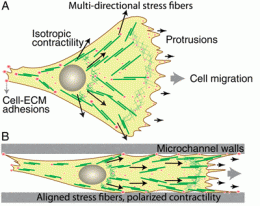Study explains fast tumor migration

(Phys.org) -- Bioengineering Professor Sanjay Kumar’s lab at the UC Berkeley today released major new research showing that tumor cells are able to migrate faster through confined spaces in the body.
The findings are published in the Proceedings of the National Academy of Sciences, co-authored by Kumar and postdoctoral researcher Amit Pathak.
Scientists know that the invasion of tumors through tissue is regulated both by mechanical properties of the tissue, such as its stiffness, and tissue microstructure properties, such as pore size. However, past attempts to study and understand these mechanisms in detail have been complicated by the fact that it is extremely difficult to change one property without changing the other.
Through newly-developed techniques, the Kumar Lab has shown for the first time that the two parameters regulate tumor motility in very different ways and, rather surprisingly, confinement of cells actually enables them to move more rapidly and directionally than they do in wide open spaces.
The researchers have developed a microfabricated platform that enables the creation of 3D channels of independently-defined size and stiffness. This structure allowed them to see that narrow channels enable cells to develop traction against the scaffold in a more focused way.
“Since there is only one way to go,” explained Kumar, “the cell doesn’t waste its ‘energy’ exploring other avenues.”
This may be a physiologically important mechanism, as malignant brain tumors tend to infiltrate most rapidly along tissue interfaces and confined spaces, such as blood vessels and nerve tracts.
More information: www.pnas.org/content/early/201 … 073109.full.pdf+html

















